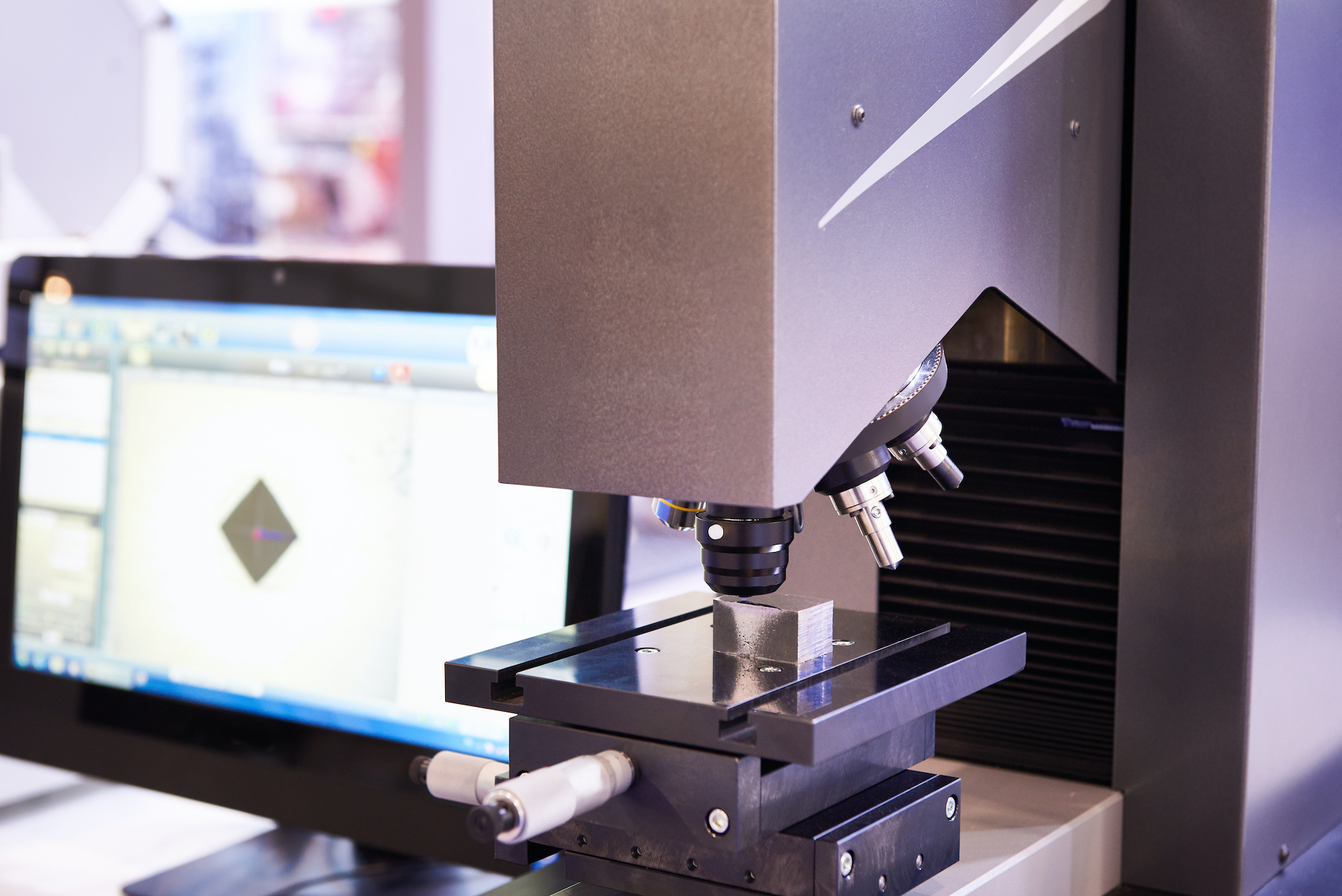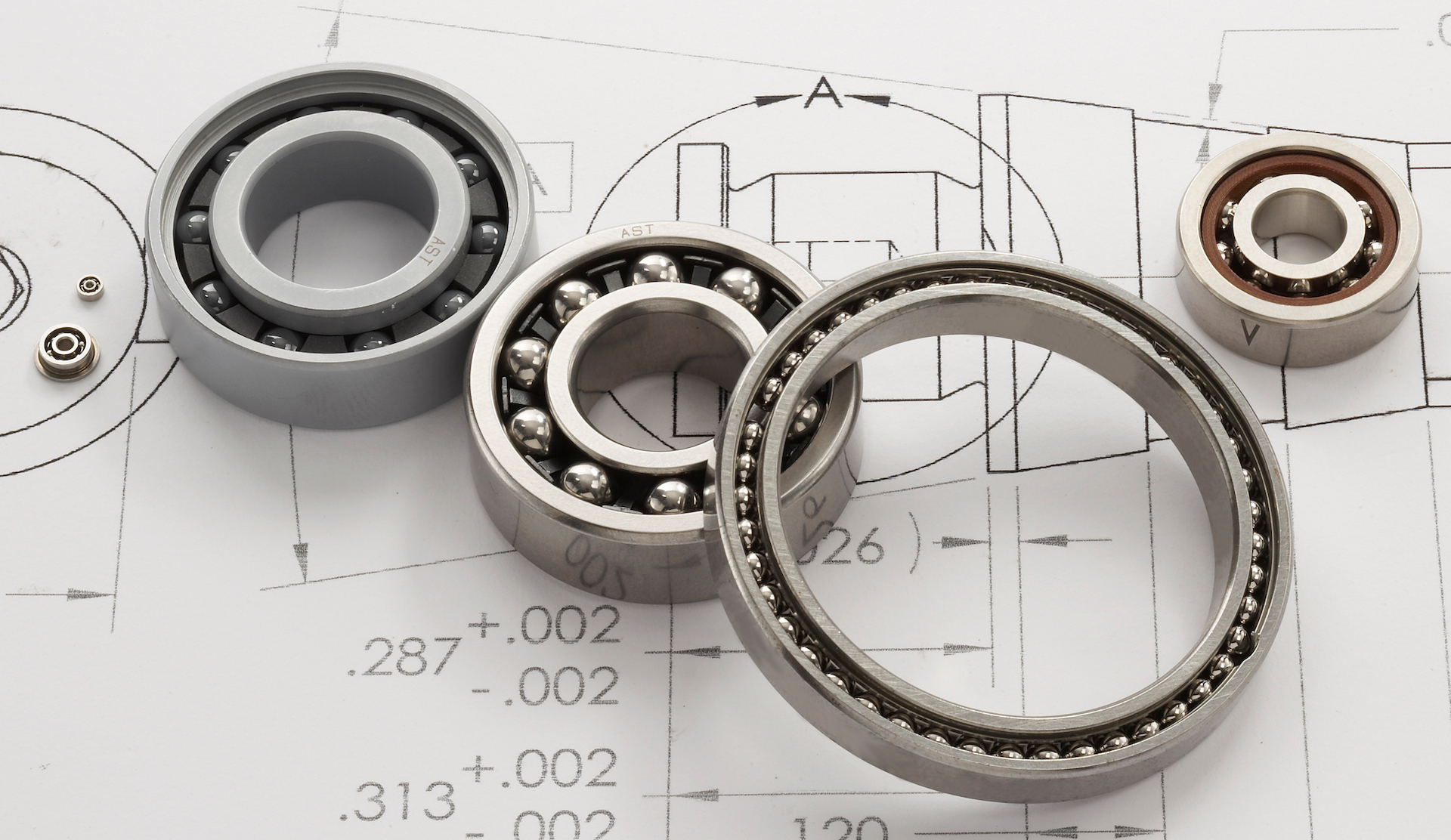In the previous installment, we discussed various types of steel bearing components to carefully consider and their compositional make-up when weighing application options. Here we will explore various types of plastic bearings and their benefits to enhance its performance and life.
The following is Part 2 of a three-part post. You can read Part 1 here.

Material hardness is the resistance to a localized plastic deformation or indentation.
Vickers hardness testing shown here involves using a 4-sided square-based pyramid
indenter, where an increasing force is applied and held for a particular dwell time,
the surface area of the indentation is measured, and the hardness is
calculated (test force, surface area).
- Plastic & Non-Metal Material Bearings
Rolling Element Bearings Made of Plastics
Usually, when users think of bearing materials, the first option they will imagine is steel. While this is undoubtedly the most common material, there is a range of other choices, each with their own unique advantages and limitations. Depending on the application type, bearing experts may advise on the use of plastic ball bearings.
The most common plastic ball bearings have both inner and outer rings constructed of an acetal base material. The balls are most often made of stainless steel, but glass or plastic balls are also readily available. Various types of plastic ball bearings are available including, deep groove or Conrad type, miniature, angular contact, self-aligning, and thrust.
Plastic bearings provide numerous advantages compared to steel or ceramic bearings. General characteristics of plastic ball bearings are:
- Grease lubrication is not required
- Excellent performance in chemical environments. It can be used (completely immersed) in water and saltwater.
- Good temperature range
- Non-magnetic and non-conductive
- Lightweight
The disadvantage of plastic bearings, when compared to traditional steel bearings, is load capacity, deflection, and lack of stiffness. They are typically used in lightly loaded mechanisms and equipment, running at low to moderate speeds.
A variety of other plastic materials are available as well. Consult with a bearing professional to ensure you make the right choice for your application.
Phenol plastic — Phenolic resin consists of phenol and formaldehyde thermosetting resin as raw materials, which are artificially synthesized. Since it is produced from resins similar to phenols cresol, these types of materials are frequently called “phenolic resins.” This material is highly resistant to oils and chemicals; it has strong heat resistance but is poor in alkalis. It is non-conductive and non-magnetic.
PTFE is commonly known as Teflon R polytetrafluoroethylene. TEFLON is a registered trademark of DuPont. Characteristics include low surface friction, resistance to corrosion and chemicals, high resistance to heat with a wide temperature range of 196 ~ 260 °C, and a water absorption rate of 0%. This material is often used in medical equipment.

Various radial ball bearing sizes and styles.
UHMW (ultra-high-molecular-weight polyethylene) is a high molecular-weight thermoplastic resin. This special kind of polyethylene is produced via advanced polymerization techniques. Characteristics include excellent chemical resistance, low water absorption, excellent abrasion resistance, retains its properties at low temperatures, and lightweight.
PEEK is a crystalline thermoplastic. It is a type of special, synthetic aromatic-polyetherketone.
Characteristics include very high heat-resistance, excellent fatigue-resistance, tough abrasion-resistance, strong dimensional stability, excellent chemical resistance, and excellent insulation and radiation-resistance. PEEK is very expensive.
Applications for plastic ball bearings:
- Conveyor systems used in cleaning systems, surface treatment, or plating equipment. Corrosive liquids are often encountered in these applications.
- Food processing equipment
- Medical imaging equipment
- Pumps and spray equipment
- Plain, or Sliding Bearings, Made of Plastics
Plain bearings are cylindrical sleeves that have no rolling elements. They are the most straightforward and lowest cost type of bearing. When sliding radially or axially over shafts, they can accommodate both rotary motion and linear motion. They can handle light to moderate radial loads.
One of the more common types is plastic sleeve bearings (which often depend on a hydrodynamic or a full film of lubrication). Self-lubricating plastic bearings in various geometries for bushings, thrust bearings, and integral-slide applications are also available.
There are hundreds of different types and blends of plastic material available for plain sleeve bearings. They provide a wide range of mechanical and physical properties that enhance the suitability of the bearing for different applications, such as low friction, anti-wear, high temperature, food-grade, and high load.
Advantages of plastic plain bearings include:
- High production volume and low cost
- Maintenance-free operation (run dry)
- Lower friction
- Excellent wear resistance
- Chemical resistance and low water absorption
- Non-conductive
Stay tuned for more on the alternative types of bearing materials beyond steel and plastic as described by AST engineers in How to Choose the Right Bearing Material for the Job – Part 3. Coming March 26.

